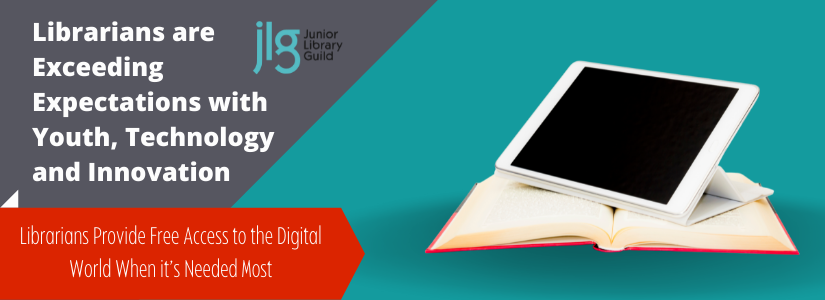How Librarians are Exceeding Expectations with the Youth, Technology and Innovation (And Here’s the Research to Back It)


We know that librarians have plenty of challenges to take on, both strategically, long term and on the daily. The modern librarian is not only a curator, they are a tech expert, an innovator, and so much more. Research points out the impact that librarians are making when it comes to access of technology, and so we have gathered the latest data, as well as a few success stories to highlight the biggest takeaways that reveal not only what patrons want from their libraries in terms of technology, but how librarians are exceeding their expectations.
From Accessibility to Innovation, Librarians are Viewed as Technology Champions
Librarians Provide Free Access to the Digital World When it’s Needed Most
As information and technology grow more interwoven into the fabric of life, technology has become an ever-important role in both public and school libraries that patrons of both, place great value upon. According to Pew Research, access to technology is rated by library users as equally important to books, as well as the services and guidance of librarians, and with good reason.
While the pandemic greatly exposed the digital divide, the American Library Association revealed that 67% of public libraries are the only source providing free internet access and computers to their respective communities. To further elaborate, a librarian from Pew Research’s online panel in the above study stated, “As a public library in a poverty-stricken rural community, we provide the only link to the outside world through our computers...We, at the library, are working to develop a way to provide internet access and computers to everyone in our county.”
In spite of the obstacles that were faced, libraries were beacons of light throughout the pandemic, offering free wi-fi, hot-spots for internet access, and technology-enabled online services and resources to patrons, such as virtual storytimes for children and subscription services (like JLG’s Gold Standard eBooks and audiobooks subscription service)
Librarians are Drivers of Innovation
How Librarians are Creating and Reimagining Makerspaces for Children and Teens
Aside from providing the basics like internet access, computers, copy machines, printers, scanners, tablets, and e-readers, more libraries are providing innovative tools to draw kids and teens back to the library, which is right on par with what the American public believes to be a crucial service that libraries should provide. According to Pew Research, “Americans are most adamant that libraries should devote resources to services for children; over eight in ten Americans say that libraries should “definitely” coordinate more closely with local schools in providing resources to kids (85%).”
And libraries, both public and private, are doing exactly that. While youth services librarians are continuing to provide youth-targeted resources like free virtual tutors, hands-on makerspaces, and STEM library programs, some school libraries are collaborating with teachers and technology coordinators to adapt to the rapidly-changing needs of their students.
At the Big Walnut Middle School in Sunbury, Ohio, for example, they had an increase of student use by 1000% through making the library experience a “learning center,” an extension of the classroom that caters more to personalized learning. By offering interactive technologies that amped up the creativity for classroom projects, students were eager to spend time in their school library, where they had hands-on access to a greenscreen room equipped with an ipad, film and video editing software, an interactive projector, digital cameras and interactive table-top touch screens.
(Considering something like this for your library? Visit the Big Walnut Middle School website or find out more about funding here.)
How Youth Services Librarians are Reimagining Spaces for 21st Century Skills
Because libraries are increasingly expanding from a place of knowledge to a place of creativity, school libraries have been collaborating with teachers to help extend their classroom activities into a larger, more creative and collaborative space where furniture and technology are movable and adaptive to student needs. As the principal of Big Walnut Middle School puts it, “There wouldn’t be one (piece of) technology that I wouldn’t give up out of the furniture,” she says. “The way the kids can move and go…working together in pairs or partners or large groups, or if the teacher does come down and use it and we rearrange the furniture—that’s where I see the creativity of how they’re collaborating.”
In public libraries, librarians are responding to the changing needs of adolescents by creating “hangout” spaces and activities for teens, especially as they grow older. As one public librarian stated in the Pew Research focus group, “Interacting with children and young adults at their schools is an important aspect of encouraging these groups to use the library at a young age... These groups may be more likely to use the library as adults if they are comfortable there as children.”
So what do the kids have to say about all of this? Research shows that they like it. Compared to older adults, younger Americans were more interested in their libraries having “comfortable spaces for reading, working, and relaxing, offering more interactive learning exhibits, offering free early literacy programs, coordinating more with local schools, and moving most services online.”
Librarians are Vital to Libraries
Technology and innovation aside, when it comes to how the general public feels about librarians, both public and school librarians have made lasting impacts, many library patrons citing how they still recall the positive memories from childhood of their interactions that they had.
The final and perhaps most valuable takeaway? Whether librarians are fulfilling their role as technology champions, innovation facilitators or simply helping patrons find what they need, it’s clear that librarians are seen as incredibly valuable to our communities and will remain essential and vital to the public and school library, no matter where the future brings us.
Sources:




